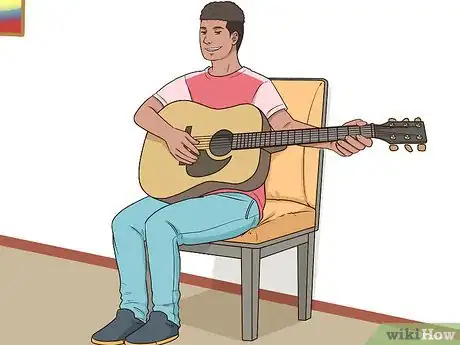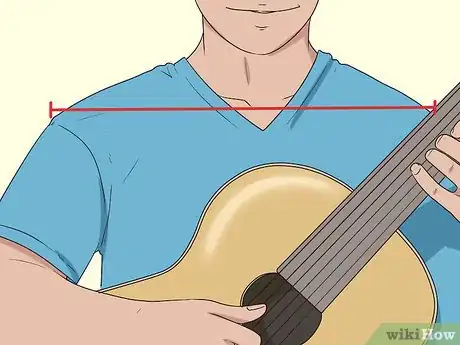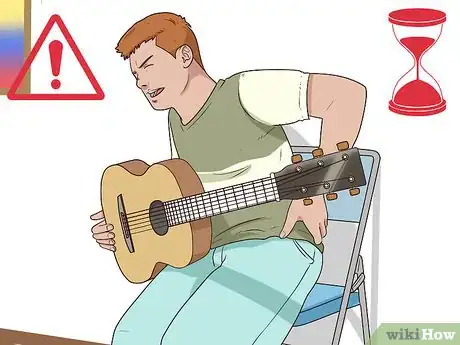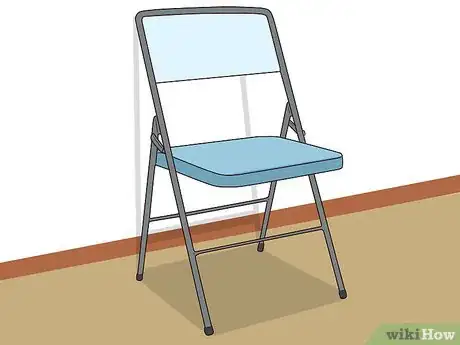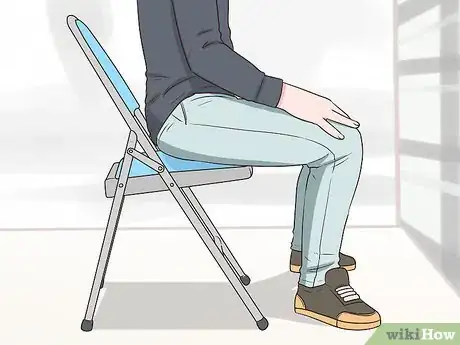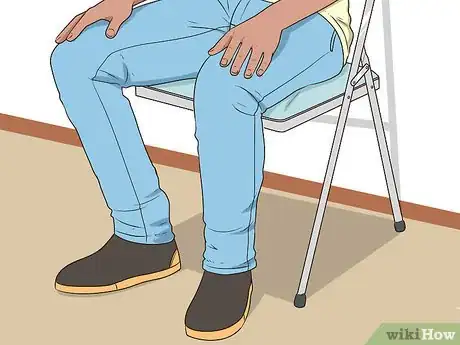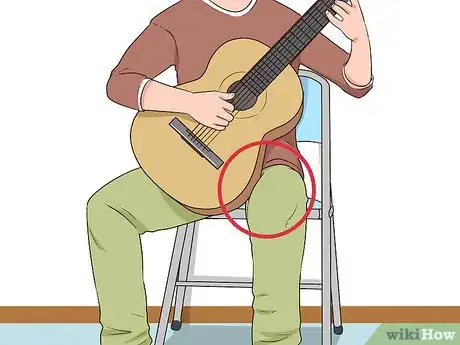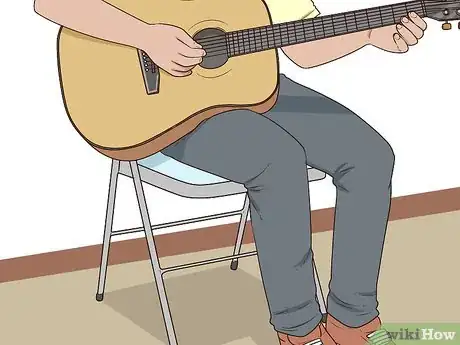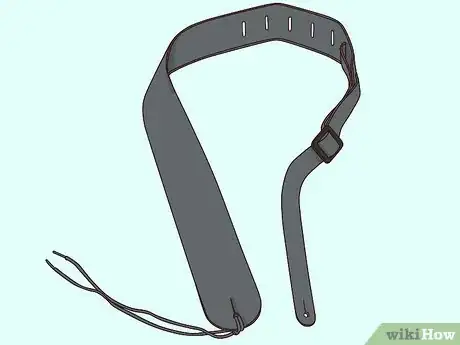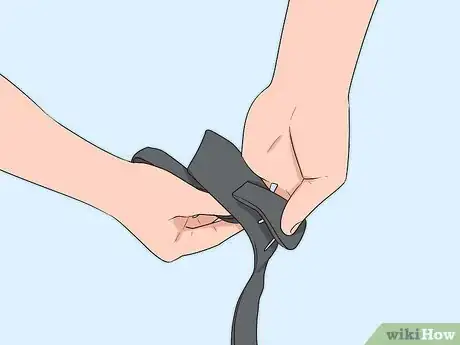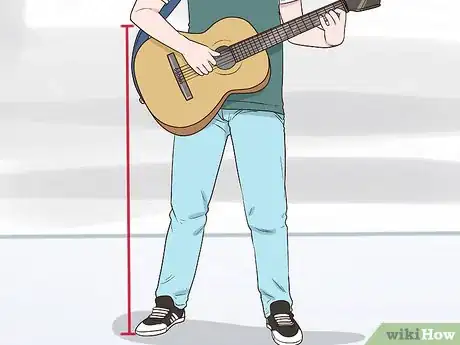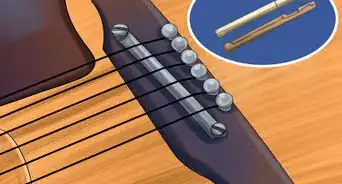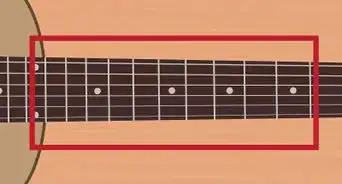This article was co-authored by Nicolas Adams. Nicolas Adams is a 5th generation musician of Serbian Gypsy descent and the lead guitarist of the band Gypsy Tribe. Based in the San Francisco Bay Area, Nicolas specializes in Rumba Flamenco and Gypsy jazz and playing the guitar, Bouzouki, Balalaika, and piano.
There are 7 references cited in this article, which can be found at the bottom of the page.
This article has been viewed 68,942 times.
Developing the correct posture is very important when learning to play the guitar in a natural, healthy way. By keeping your upper body relaxed and learning how to have proper posture while standing and sitting, you will be able to play to your best ability while also avoiding injury. Holding and playing the guitar will even begin to feel subconsciously natural after you have gotten comfortable with the instrument.
Steps
Maintaining Proper Upper Body Posture
-
1Keep your back straight and your shoulders relaxed. While practicing, keep your back as straight as you can without putting any strain on your lower back. Position your neck, shoulders, and back in a straight line, focusing on upper body alignment. This position will provide you with more dexterity and flexibility, while helping to avoid back problems.[1]
- Avoid leaning back into your chair, even if you are able to keep a straight back, as this may cause back problems and won’t allow you to move as well.
-
2Keep your shoulders level to avoid injury. Focus on keeping your shoulders relaxed, while keeping a slight pressure in your shoulder blades. Although your shoulders may shift while playing complicated compositions, you should maintain a levelness through most of your play.[2]
- If it is difficult to keep your shoulders level, it may mean that your guitar is out of position and that you need to adjust its placement.
Advertisement -
3Use a mirror to monitor your posture. Play in front of a mirror while you practice and check on your body alignment, focusing on keeping your head, neck, and shoulders aligned. Looking into the mirror will also help you monitor your shoulder placement. Watch to see if you look tense in any one area of your upper body.[3]
- You can also monitor your posture by recording yourself with a camera during a practice session.
-
4Avoid practicing for too long without taking a break. You should not practice for more than thirty minutes to an hour without taking a short break to rest your upper body. During your break, set the guitar down and do some upper body stretches, focusing on your back and shoulders. Allow your upper body to rest so that you do not become tense while playing over longer periods of time.[4]
- Proper rest will decrease your chances of injury and allow you to maintain a consistent level of performance while practicing.
Sitting with Good Guitar Posture
-
1Purchase a folding chair to sit on while playing. Find a folding chair, or any chair that is low to the ground. Make sure that the chair allows you to comfortably sit up straight. Sitting on a couch or bed will make it difficult to practice good posture while playing guitar and could cause injuries.[5]
- Also avoid using a comfortable office chair, as these won’t allow you to sit up straight and can cause back problems.[6]
-
2Sit at the front of the chair to avoid slouching. Using the back of the chair as support for your back and shoulders will make it hard to have proper posture. Do not rely on the chair for support and focus on staying at the front of the chair the entire time you play.[7]
-
3Keep your feet flat on the ground. Place both feet solidly on the ground and spread them apart in a way that feels most comfortable. Keeping your feet flat on the ground will allow you to keep proper posture in your back, while allowing you to properly rest the guitar on your thigh.
- If you feel yourself raising one of your legs to support the guitar, it may mean that your chair is too high or that your guitar placement needs to be changed.
-
4Place the base of the guitar on your left leg for a classical posture. When playing an acoustic guitar, you can play in a classic guitar style by keeping the guitar closer to the center of your body. The guitar will fit between your legs, resting on the inner part of your left thigh, and the guitar will stand at a 45 degree angle. In this position, you will place your left leg on a footstool, which will keep the guitar raised and in the proper position.[8]
- Classical guitar positioning takes support away from your left arm, allowing you to play more difficult compositions.
-
5Place the guitar on your right thigh for a regular acoustic position. Use regular acoustic positioning if you are not playing complicated guitar compositions. The guitar will be more horizontal in this position, with your right forearm gently resting on the lower bout, or the bottom curve, of the guitar.[9]
- Allow the guitar to sit at a slight angle, and do not support the fretboard of the guitar with your left hand, allowing the guitar to balance on your thigh.
-
6Rest your right forearm on the lower bout of the guitar. With your forearm on the bottom curve of the guitar, you should not be supporting the neck of the guitar with your left hand. Check that you are not supporting the neck of the guitar by taking your left hand completely off of the guitar.[10]
Standing with Proper Guitar Posture
-
1Purchase a guitar strap before playing the guitar while standing. Guitar straps are an integral part of playing the guitar while standing, and they can be purchased online for as low as five dollars. Once you receive the strap, attach it to the two strap pins on the bottom and top of your guitar. Follow the directions that come with your strap to ensure that the strap is secured before playing.[11]
- If your strap is not securely fastened to your guitar, you may run the risk of the guitar falling from your body while playing.
- Although you can find very cheap straps online, there are also many other expensive options. If you have the money, express yourself by choosing a cool, fashionable strap that fits your look.[12]
-
2Adjust the strap to fit your style of playing. With the guitar strap properly attached, put the strap over your head and let it fall naturally at your waist. If you prefer playing with the guitar in a low position, like some rock ‘n roll guitarists, adjust the strap to let the guitar fall a bit lower. If it is too low, adjust the strap to raise the guitar.[13]
-
3Angle your guitar to 45 degrees with strap adjustments. If your guitar is completely horizontal or completely vertical, you need to adjust your strap. When your guitar is horizontal, you can reposition the strap on your shoulder, allowing the base of the guitar to fall more, angling the neck up. If your guitar is too vertical, loosen the strap some to lower it.[14]
- Keeping your guitar at a 45 degree angle will allow your hands and shoulders to fall naturally onto the guitar. Try to point your thumb towards the head stock to avoid wrist injuries.
-
4Keep your feet in line with your shoulders. Even though you may be moving around while playing, proper posture comes from keeping your feet spread in a natural way. Planting your feet below your shoulders will keep your entire body in line and will help you avoid back injuries while playing.[15]
Expert Q&A
Did you know you can get expert answers for this article?
Unlock expert answers by supporting wikiHow
-
QuestionHow should you sit when playing guitar?
 Nicolas AdamsNicolas Adams is a 5th generation musician of Serbian Gypsy descent and the lead guitarist of the band Gypsy Tribe. Based in the San Francisco Bay Area, Nicolas specializes in Rumba Flamenco and Gypsy jazz and playing the guitar, Bouzouki, Balalaika, and piano.
Nicolas AdamsNicolas Adams is a 5th generation musician of Serbian Gypsy descent and the lead guitarist of the band Gypsy Tribe. Based in the San Francisco Bay Area, Nicolas specializes in Rumba Flamenco and Gypsy jazz and playing the guitar, Bouzouki, Balalaika, and piano.
Professional Guitarist
-
QuestionHow can I play guitar without hurting my back?
 Nicolas AdamsNicolas Adams is a 5th generation musician of Serbian Gypsy descent and the lead guitarist of the band Gypsy Tribe. Based in the San Francisco Bay Area, Nicolas specializes in Rumba Flamenco and Gypsy jazz and playing the guitar, Bouzouki, Balalaika, and piano.
Nicolas AdamsNicolas Adams is a 5th generation musician of Serbian Gypsy descent and the lead guitarist of the band Gypsy Tribe. Based in the San Francisco Bay Area, Nicolas specializes in Rumba Flamenco and Gypsy jazz and playing the guitar, Bouzouki, Balalaika, and piano.
Professional Guitarist
-
QuestionIs it okay if I don't play with perfect posture?
 Nicolas AdamsNicolas Adams is a 5th generation musician of Serbian Gypsy descent and the lead guitarist of the band Gypsy Tribe. Based in the San Francisco Bay Area, Nicolas specializes in Rumba Flamenco and Gypsy jazz and playing the guitar, Bouzouki, Balalaika, and piano.
Nicolas AdamsNicolas Adams is a 5th generation musician of Serbian Gypsy descent and the lead guitarist of the band Gypsy Tribe. Based in the San Francisco Bay Area, Nicolas specializes in Rumba Flamenco and Gypsy jazz and playing the guitar, Bouzouki, Balalaika, and piano.
Professional Guitarist
References
- ↑ Nicolas Adams. Professional Guitarist. Expert Interview. 17 September 2019.
- ↑ https://www.classicalguitarcorner.com/the-sitting-position/200/
- ↑ https://www.classicalguitarcorner.com/the-sitting-position/200/
- ↑ http://www.guitarhabits.com/how-to-hold-a-guitar-proper-posture-and-hand-positioning/
- ↑ http://hubguitar.com/articles/posture-tips-for-guitar-players
- ↑ http://hubguitar.com/articles/posture-tips-for-guitar-players
- ↑ http://hubguitar.com/articles/posture-tips-for-guitar-players
- ↑ http://www.dummies.com/art-center/music/guitar/perfect-postures-for-playing-guitar/
- ↑ http://www.dummies.com/art-center/music/guitar/perfect-postures-for-playing-guitar/
- ↑ http://www.dummies.com/art-center/music/guitar/perfect-postures-for-playing-guitar/
- ↑ http://www.dummies.com/art-center/music/guitar/perfect-postures-for-playing-guitar/
- ↑ http://www.seymourduncan.com/blog/the-players-room/straps-and-strap-height-playing-while-looking-cool
- ↑ http://www.seymourduncan.com/blog/the-players-room/straps-and-strap-height-playing-while-looking-cool
- ↑ https://www.guitar-muse.com/technique-are-you-holding-that-guitar-right-posture-wrist-thumb-and-more-5718
- ↑ https://www.guitar-muse.com/technique-are-you-holding-that-guitar-right-posture-wrist-thumb-and-more-5718
